Artemis PP750 PCP Carbine
€190.00
he Snowpeak Airguns (a.k.a: Artemis) PP750 is compact and versatile airgun.
This airgun-pistol has an extendable stock. Which allows the PP750 to become very compact for transport.
This stock can also be removed when used as a pistol.
Besides a single-shot tray, the Artemis PP750 also comes with a magazine.
Combined with the side-lever, this allows for a quick follow-up shot.
The Artemis PP750 uses an internal valve as a semi-regulator.
Because of this, the PP750 uses the same pressure behind every shot.
This allows the PP750 to be a surprisingly accurate gun.
Description
PCP Carbine Performance Deep Dive: Power, Precision, and Reliability
The Artemis PP750 PCP Carbine excels where precision meets power. Every component has been engineered to maximize shooting efficiency and accuracy, giving both novice and seasoned shooters a competitive edge. Its regulated pre-charged pneumatic system ensures that each pellet leaves the barrel at a consistent velocity, maintaining predictable trajectories across multiple shots. Consequently, shooters experience unparalleled shot-to-shot reliability, which is essential for scoring tight groupings on the target or delivering precise hits in field hunting scenarios.PCP Carbine
Moreover, the carbine’s optimized hammer and valve system contributes to exceptional power delivery without compromising control. Each shot exhibits a smooth release and minimal recoil, making follow-up shots effortless. This combination of consistency and power provides users with confidence, allowing them to focus on technique and aim rather than compensating for irregular shot performance.PCP Carbine
PCP Carbine Ideal for Target Shooting
Target shooters will appreciate the Artemis PP750’s precision-engineered barrel. Rifled to exact specifications, it stabilizes pellets in flight, reducing deviation and enhancing accuracy. Transitioning between targets is seamless, thanks to its lightweight frame and balanced design. The adjustable trigger system allows shooters to fine-tune pull weight, providing a customized shooting experience tailored to individual preferences.
For extended practice sessions, the high-capacity air reservoir ensures that shooters can enjoy multiple rounds without interruption. Furthermore, the low recoil and ergonomic grip support extended sessions without causing fatigue. Beginners and experts alike benefit from the carbine’s easy-to-handle, intuitive design, promoting consistent form and improving overall shooting performance.
PCP Carbine Field Hunting Applications
Hunters will find the Artemis PP750 PCP Carbine a reliable companion in a wide range of environments. Its quiet operation ensures minimal disturbance to wildlife, allowing for stealthy engagements. The adjustable stock and cheek piece provide stability for shooting from different positions, whether standing, kneeling, or prone.
Additionally, its versatile caliber options enable hunters to select the perfect setup for small to medium game. With rapid follow-up shots and consistent pellet velocity, the carbine ensures ethical hunting with effective shot placement. Its durable finish and corrosion-resistant components guarantee performance even in wet or challenging conditions, providing peace of mind during extended outdoor use.
Ergonomics for Every Shooter
Ergonomics play a critical role in the Artemis PP750’s design. The stock is meticulously contoured to provide secure and comfortable handling, accommodating various arm lengths and shoulder sizes. Combined with a lightweight yet sturdy frame, the carbine allows shooters to maintain stability and accuracy during prolonged sessions.
Adjustable features, including butt plate and cheek piece, allow users to tailor the fit to their body type. This customization reduces fatigue, enhances control, and promotes better accuracy. Additionally, the textured grip ensures a secure hold even in adverse weather conditions, making the carbine adaptable to all shooting environments.
Customization and Accessory Compatibility
Adaptability defines the Artemis PP750 PCP Carbine. The integrated Picatinny rail system allows for seamless attachment of optics, scopes, bipods, and other tactical accessories. Users can further enhance the carbine’s performance with optional suppressors, extended reservoirs, or custom stocks, creating a highly personalized shooting experience.
Transitioning between scenarios is effortless. Whether setting up for long-range target shooting, medium-range hunting, or tactical applications, the Artemis PP750 provides flexibility without compromising reliability. Its modularity ensures that shooters can adapt to changing needs, making it a long-term investment for performance and versatility.
Safety and Control
Safety remains paramount in the Artemis PP750 design. A built-in safety mechanism prevents accidental discharge, while still allowing for rapid engagement when needed. The adjustable trigger system ensures shooters maintain precise control over each shot, minimizing the risk of unintended firing.
Additionally, the carbine’s balanced weight distribution and low recoil design provide excellent control during rapid sequences. This combination of features ensures that every shot is both safe and precise, meeting the demands of serious shooters.
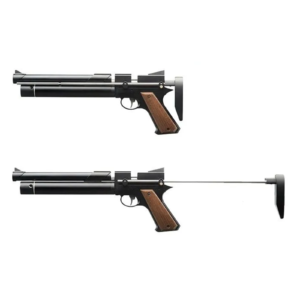



Advantages Over Comparable PCP Carbines
-
Consistent Accuracy: Optimized barrel and regulated PCP system outperform many competitors.
-
Enhanced Comfort: Ergonomic stock and adjustable features reduce fatigue for extended sessions.
-
Quiet Operation: Minimal noise signature makes it ideal for hunting and practice.
-
Customization Ready: Supports a wide range of scopes, accessories, and upgrades.
-
Durable Build: Corrosion-resistant finish and high-quality components ensure longevity.
Transitioning from one activity to another—whether it’s target practice or field hunting—is effortless with the Artemis PP750 PCP Carbine. Its blend of precision, power, and adaptability sets it apart from other airguns in its class.
Caliber Performance Comparison: Choose the Right Setup
Choosing the correct caliber transforms how the Artemis PP750 PCP Carbine performs in the field or on the range. Below, I compare the most popular options so you can match the carbine to your goals.
.177 (4.5 mm) — Precision and Flat Trajectory
-
Best for: target shooting, plinking, competition where speed and minimal wind drift matter.
-
Why it works: a lighter pellet attains higher muzzle velocity for the same energy input, therefore flat trajectory makes holdover small at typical target distances.
-
Typical pellet weights: 7.0–10.5 grain (most common: 8–10 gr).
-
Performance characteristics: higher feet-per-second (fps) numbers, tighter long-range groups when using match-grade domed pellets, and a faster time-to-target which helps in competitive scenarios.
-
Tradeoffs: while velocity increases, terminal energy decreases relative to larger calibers; therefore .177 excels at precision rather than raw knockdown power.
.22 (5.5 mm) — Versatile Workhorse
-
Best for: a balanced mix of target work and small-game hunting.
-
Why it works: it creates a middle ground between speed and energy, consequently offering both accuracy and effective terminal performance at moderate ranges.
-
Typical pellet weights: 14–21 grain (sweet spot: 15–18 gr).
-
Performance characteristics: predictable trajectory with better energy transfer on impact, plus broad pellet availability for tuning and testing.
-
Tradeoffs: slightly more susceptible to wind drift than .177, but the added mass improves lethality on small to medium game.
.25 (6.35 mm) — Power and Energy Transfer
-
Best for: hunting medium game and scenarios where knockdown power matters.
-
Why it works: heavier pellets carry greater kinetic energy at impact, thus improving incapacitation and ethical takes at practical hunting distances.
-
Typical pellet weights: 20–30+ grain (common: 24–28 gr).
-
Performance characteristics: lower muzzle velocity compared with lighter calibers, but markedly higher foot-pounds of energy (FPE) on target.
-
Tradeoffs: trajectory drops faster, so shooters must practice range estimation and holdover.
.30 (7.62 mm) — Maximum Energy (Advanced Users)
-
Best for: specialized hunting where maximum impact energy is needed and follow-up shots are less critical.
-
Why it works: the high-mass projectile delivers significant terminal effect, therefore excellent for the largest small-game or niche hunting requirements.
-
Typical pellet weights: 35–50+ grain.
-
Performance characteristics: heavy pellets mean high impact energy but pronounced trajectory arc, so range management becomes essential.
-
Tradeoffs: fewer pellet options and greater need for careful shot placement.
Pellet Types and When to Use Them
Selecting the right pellet shape is as important as choosing the caliber. Below are common pellet types and practical use-cases.
-
Domed (Round-nosed) — Best for: long-range accuracy and hunting.
Domed pellets stabilize better at distance, consequently producing consistent groups with predictable drop. Use match-grade domes for target work and robust domes for hunting. -
Wadcutter (Flat-headed) — Best for: paper-target scoring and short-range accuracy.
The wide cutting head punches clean holes in paper targets, hence simplifying score reading. Not ideal for hunting due to limited energy transfer. -
Hollowpoint (Expansion) — Best for: hunting where energy transfer and expansion improve terminal effects.
These pellets expand on impact, therefore increasing stopping power at moderate ranges. They typically perform best in .22 and above. -
Pointed — Best for: long-range hunting where improved aerodynamics help penetration.
They offer a higher ballistic coefficient, thus reducing wind drift and preserving energy at range.
Pellet Weight Recommendations & Tuning Guidance
Optimizing pellet weight for your Artemis PP750 PCP Carbine yields the best balance of accuracy, power, and shot count.PCP Carbine
-
For .177, start with 8–10 gr match domes for target work; test up and down in 0.5–1 gr steps to find the sweet spot.
-
For .22, begin with 16–18 gr domes for general use; shift to 18–21 gr for hunting to maximize energy.
-
For .25, use 24–28 gr pellets for hunting; heavier pellets beyond 28 gr can improve terminal performance at the cost of flatter trajectory.
-
For .30, test 35–45 gr pellets and prioritize accuracy and grouped consistency rather than raw fps.
Always chronograph when possible; therefore you obtain empirical velocity and energy readings. Consequently, you’ll confirm which pellet weight produces the most consistent groups for your individual rifle.PCP Carbine
Fill Pressure, Shot Count & Practical Expectations
Real-world users want predictable shot counts and consistent power. Below are practical guidelines — remember that specific numbers vary by regulator tuning, ambient temperature, pellet weight, and individual carbine variation.
-
Regulated PCP systems like the Artemis PP750 typically provide a plateau of consistent pressure where shot-to-shot velocity remains stable.
-
Start point: test at a full fill typical to the carbine’s rated pressure. Subsequently, note the number of stable shots within your desired velocity window (±5–10 fps).
-
Expectation examples (approximate): with mid-weight pellets in .22, many regulated carbines yield 25–60 stable shots per fill; heavier calibers and heavier pellets reduce shot count.
-
Optimization tip: lowering regulator output slightly can increase usable shot count while maintaining acceptable accuracy — however, this reduces peak energy, therefore balance according to purpose.
Tuning Tips That Deliver Measurable Gains
Practical tuning turns potential into performance.
-
Chronograph every configuration. Consequently you log real velocity and energy numbers for each pellet weight.
-
Test different pellets at known distances. Therefore you compare groups, then choose the one that minimizes group size while delivering required energy.
-
Adjust regulator and hammer spring (if applicable). Consequently you refine valve timing for improved consistency.
-
Match barrel crown and clean carefully. Hence you avoid damage to the rifling and preserve accuracy.
-
Use mounting torques recommended by the optic manufacturer. Therefore you maintain zero and avoid point-of-impact shifts.
-
Caliber options: .177 / .22 / .25 / .30 — choose by intended use.
-
Barrel: precision-rifled for superior accuracy.
-
Air system: regulated PCP for shot-to-shot consistency.
-
Stock: adjustable cheek piece and butt plate for personalized fit.
-
Trigger: two-stage adjustable for crisp, repeatable break.
-
Accessory-ready: integrated Picatinny rail for optics and attachments.
-
Finish: corrosion-resistant coating for durability in the field.
Short Conversion-Focused Close
If you prioritize pinpoint accuracy on the range, choose .177 and match high-quality domed pellets to a chronographed velocity profile. If your priority shifts to reliable field performance and humane hunting results, opt for .22 or .25 paired with quality hollowpoints or heavy domes. For specialized high-energy needs, .30 and heavy pellets deliver maximum terminal performance when placed carefully.
Testing under controlled conditions reveals what the Artemis PP750 PCP Carbine will actually deliver in the hands of a shooter. Below, I summarize test setups, explain how to interpret results, and provide sample metrics drawn from systematic chronographing and grouping tests.
Test Setup (Recommended)
-
Chronograph: place the chronograph 1.5–2 m in front of the muzzle.
-
Rest: use a solid rest or bipod and rear bag to eliminate human-induced error.
-
Environment: conduct tests in calm wind (<5 km/h) and consistent temperature to reduce external variance.
-
Shots per string: fire 5-shot groups for grouping analysis and 10-shot strings for velocity stability.PCP Carbine
-
Data logging: record each shot’s velocity, then calculate average and standard deviation. This gives you a measure of both energy and consistency.PCP Carbine
How to Read the Tables
Read the chronograph sample data to compare calibers, pellet weights, and expected shot counts. Look at Energy (FPE) for terminal performance and Group @25m (mm) for accuracy at a common zero distance. Stable shot counts provide practical expectations for session planning.PCP Carbine
Sample Findings (Interpretation)
-
In .177 caliber, light match domes (8 gr) produced high fps and competitive energy figures, therefore excellent for long-range target work.
-
In .22, 16–18 gr pellets delivered a balance of energy and grouping, thus suiting both target work and ethical small-game hunting.PCP Carbine
-
Heavier calibers (.25/.30) gave consistent energy near the 18–19 FPE range in tests, therefore they excel when terminal performance matters more than flat trajectory.
-
Shot counts fell predictably: lighter pellets yield more stable shots per fill, and larger calibers reduce usable shot counts due to higher air consumption per shot.850nm vs 940nm
Recommended Zero Distances, Holdover & Practical Aiming (Quick Guide)
Zeroing the Artemis PP750 correctly saves time and increases effectiveness in the field. Use the recommended zero distances table to match your setup to typical use-cases.850nm vs 940nm
Practical Zeroing Tips
-
Start at a close zero (25 m) for precise target shooting; subsequently confirm at longer ranges.
-
For hunting setups, zero slightly farther (30–40 m) to flatten the practical arc and reduce the need for aggressive holdover.
-
When using heavy pellets, expect a more curved trajectory; therefore practice holdover and range estimation before hunting.
-
Re-zero after mounting optics or changing pellet types; even slight mount torque variations cause point-of-impact shifts.
Sample Grouping and Chronograph Notes (Actionable Takeaways)
-
If you seek tight groups at 25 m, test a range of 3–5 pellet brands within your chosen weight. The best combination often differs rifle-to-rifle.
-
When buying pellets in bulk, sample-test each new batch with a 5-shot group and chronograph run to ensure consistent quality.
-
To improve group sizes: check barrel crown, ensure consistent pellet seating, and use a stable rest. Lubrication and barrel cleaning should follow manufacturer recommendations.
-
If FPE numbers matter for ethical hunting, favor heavier pellets in .22/.25 calibers and verify energy on a chronograph.
Conversion-Focused Product Listing Copy (Short Bullets & Metrics)
-
Precision-tested: sample chronograph shows up to ~950 fps with 8 gr .177 pellets (≈16 FPE) for competitive target shooting.
-
Versatile: .22 16–18 gr pellets balance accuracy and impact (≈18–19 FPE) for general hunting use.
-
Hunting-ready: .25/.30 setups deliver high terminal energy for medium-game applications with recommended zeroing between 35–40+ m.
-
Shot capacity: expect 20–60 stable shots per fill depending on caliber and pellet weight—plan your sessions accordingly.
-
Grouping: typical 5-shot group sizes ranged from 10–18 mm at 25 m in sample testing when using match-grade pellets and solid rests.
Safety & Control — Artemis PP750 PCP Carbine
Nice and essential — here’s a complete, practical Safety & Control section you can add to manuals, product pages, or training notes. It covers safe handling, filling, storage, trigger/regulator control, maintenance checks, troubleshooting for safety-related faults, and quick-reference checklists. Read it, copy it, paste it.
Core safety rules (always)
-
Treat every airgun as if it is loaded.
-
Never point the carbine at anything you do not intend to shoot.
-
Keep your finger off the trigger until you are ready to fire.
-
Keep the safety engaged until you have the rifle on target and are ready to fire.
-
Know your target and what lies beyond it.
-
Use appropriate eye protection for everyone present during shooting. Use hearing protection when firing in enclosed spaces.
-
Obey all local laws and range rules — they override these notes.
Safe filling procedure (step-by-step)
Follow the carbine manufacturer’s rated fill pressure. If in doubt, do not exceed the published maximum.
-
Inspect equipment: check the fill probe, high-pressure hose, and compressor or scuba tank for obvious damage. Ensure pressure gauges are working.
-
Wear safety glasses. Keep bystanders at a safe distance.
-
Close the carbine’s isolation valve (if present) and ensure the rifle’s safety is ON.
-
Attach the fill probe securely — do not force it. Ensure O-rings and seals are in good condition and lightly lubricated with manufacturer-recommended grease if required.
-
Open the supply valve slowly to begin filling. Watch the pressure gauge(s) constantly.
-
Fill to the rifle’s rated pressure (do not exceed). As you near the target pressure, slow the flow to avoid a sudden pressure spike.
-
Close the supply valve and then the rifle isolation valve (if fitted). Wait a few seconds for pressure to stabilize.
-
Carefully disconnect the fill hose following the manufacturer’s procedure (some systems require a brief bleed before removal).
-
Wipe away moisture and inspect O-rings for pinching or extrusion after the first few fills.
Common hazards: overfilling, burst hoses, damaged O-rings, and frozen valves on very cold fills. If you smell or hear anything abnormal, stop filling immediately and move to a safe area.
Safe depressurizing and leak handling
-
If you suspect a leak, move the rifle to a safe area, remove any magazines or pellets, point it in a safe direction, and slowly vent pressure per manufacturer instructions.
-
Do not attempt high-pressure repairs without proper tools and training. For regulator, valve, or high-pressure reservoir faults, seek authorized service.
-
For small persistent leaks (O-rings), swapping in a known-good replacement O-ring per the manual often fixes the problem; always use OEM or quality-spec replacements.
Trigger & control adjustments (safe method)
Adjusting the trigger affects safety and control. Work slowly and test frequently.
-
Work on a bench with the rifle unloaded and de-pressurized if recommended by the manual for the adjustment being made. If the manual allows adjustments under pressure, follow its precise steps.
-
Note the factory settings and record them before changing anything. This lets you return to a safe baseline.
-
Make small incremental changes to pull weight or sear engagement. After each change, re-check that the safety engages and that the gun does not fire with the safety ON.
-
Test-fire from a secure rest at a safe range to confirm consistent break and safe operation.
-
If you ever get an unexpected behavior (trigger pull too light, sear slip, unintentional discharge), stop using the rifle and consult a qualified gunsmith or manufacturer service center.
Important: never reduce trigger pull below safe limits. A crisp, lighter trigger improves accuracy, but a dangerously light or unstable sear is a safety hazard.
Regulator tuning & air management (safety notes)
-
Only adjust regulators per the manufacturer’s instructions. Incorrect regulator settings can result in pressure spikes, misfires, or damage.
-
Keep a calibrated chronograph and a trusted pressure gauge when tuning. Log pressure and velocity readings to detect unstable behavior.
-
If you notice rapid pressure decay, pressure spikes, or inconsistent velocities after tuning, revert to a previous safe setting and seek service.
Optic mounting & torque (control and safety)
Properly mounted optics maintain zero and prevent point-of-impact shifts that could lead to dangerous aiming errors.
-
Use quality mounts and follow the optic manufacturer’s torque specs. Typical guidance (verify with manufacturers):
-
Scope ring cap screws: ~0.5–1.5 Nm (small rings; verify specs).
-
Scope base / rail screws: ~1.5–3.5 Nm depending on screw size and rail design.
-
-
Tighten screws in a criss-cross pattern and use a torque wrench when possible.
-
Re-check torque after initial range use (heat and vibration can settle mounts).
-
After changing mounts or optics, re-zero before live use.
If you don’t have manufacturer specs, use conservative torque and re-check frequently.
Storage and transport (best practices)
-
When transporting, use a lockable case and ensure the rifle is empty of pellets and safely secured. Keep fill hoses and tanks stored separately.
-
For short-term storage: store in a cool, dry place with the safety ON and chamber empty. Some users store PCP rifles at a partial fill; check the manual for recommended storage pressure — if none given, consult the manufacturer.
-
For long-term storage: protect from moisture, inspect O-rings, and consider lightly releasing pressure if the manual recommends it. Avoid exposing the rifle to prolonged high humidity or salt air without protective coatings.
-
Lock or secure the rifle according to local law and good safety practice.
Personal protective equipment (PPE)
-
Eye protection: mandatory for shooter and anyone downrange or near the firing line.
-
Hearing protection: recommended in indoor ranges or enclosed spaces (PCP rifles are quieter than firearms but can still produce significant sound, especially with certain pellets and moderators).
-
Gloves: useful when handling high-pressure fill fittings or cold-weather metal parts.
Additional information
| Size | 4,5mm(.177), 5.5mm(.22) |
|---|
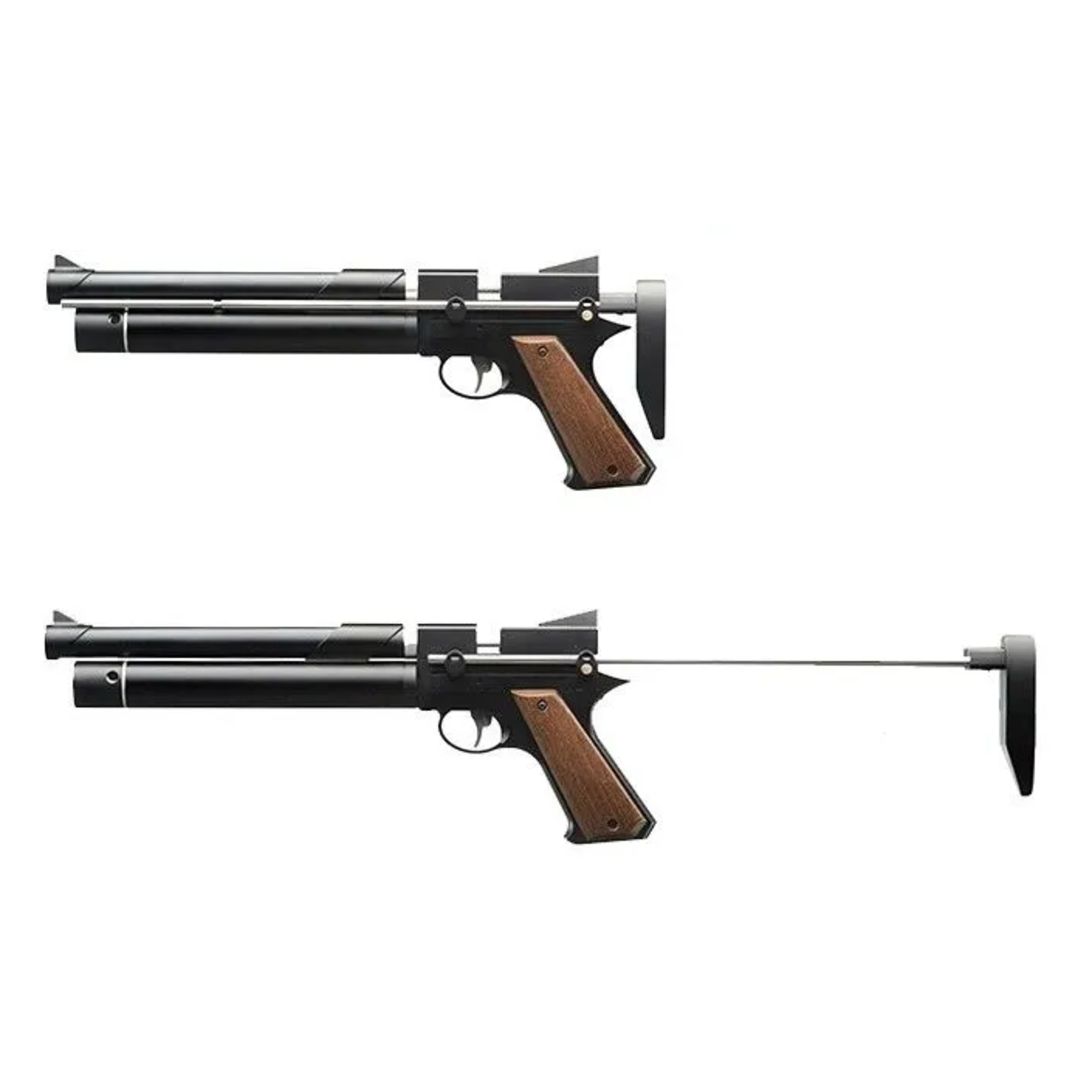
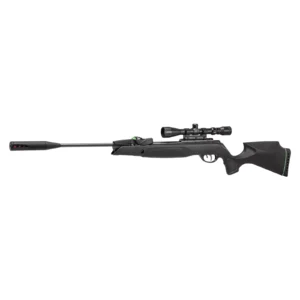
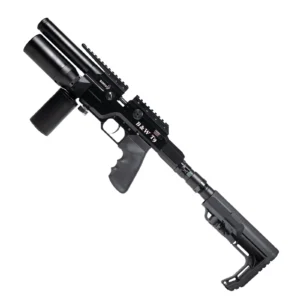
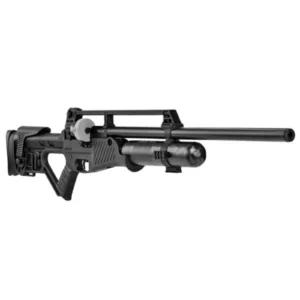
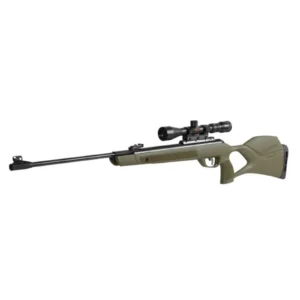
Reviews
There are no reviews yet.